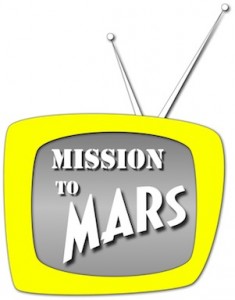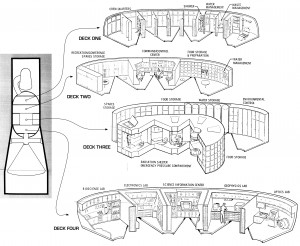 In our previous installment, the crew of the Percival Lowell arrive at their new ship in preparation for their historic journey to Mars, only to find a most unexpected stowaway . . .
In our previous installment, the crew of the Percival Lowell arrive at their new ship in preparation for their historic journey to Mars, only to find a most unexpected stowaway . . .
* * *
The crew gathered in a circle around the duffel bag out of which poked the furry gray head of a cat who, once he caught sight of Boggins, purred inquisitively. For a few moments, there was silence as no one knew what to say.
Boggins broke the spell. “Can we keep him?” he asked to no one in particular.
“Absolutely not!” replied Endicott flatly and without hesitation.
“Aw, why not?” Serrona said in a soothing French accent. He reached out his right hand to the bag, scratching the cat behind its ears and causing the cat to purr even more loudly. Clearly, it was adjusting fast to its gravity-less surroundings.
“All our consumables are balanced for five,” Endicott said. “Food, water, air, and everything else. We can’t disrupt that now. Right, Colonel?” Endicott looked at Braden, who floated next to him.
Braden looked at the cat and at the rest of the crew, all of whom clearly agreed with Serrona. She was glad to see that, because she too was inclined to keep the cat despite the fact that it broke every regulation in the book.
Or was it because of that?
“This isn’t up for a vote,” Braden said. Everyone nodded solemnly. Braden paused as she thought about what to do next. “What’s his name?” she asked Boggins.
“He . . . uh, he doesn’t have a name, skipper.”
“Hmmm,” she said. “How about Percy? For Percival Lowell.”
“Colonel, you can’t be serious!” Endicott fumed.
Braden put up her hands in placation. “Hear me out, Taff,” she said. “It’s going to be a long trip. We could all do with a mascot. She could be our good-luck charm.”
“It’s a ‘he,’ skip,” interjected Boggins.
Braden nodded in response. “Why should humans be the sole ambassadors of their planet to make this trip?”
“Besides,” said Boggins, “to Percy here, Mars is going to look like the galaxy’s biggest litter box.”
Endicott’s mouth twitched as he fought to keep from smiling. Then he turned to the handful of launch technicians floating nearby. “Hey, fellows,” he said, gesturing them over.
The technicians floated over. “Yes, sir?” said the senior one.
“Two things. One, you are sworn to absolute secrecy about Percy here,” he nodded sideways at the floating duffel. They nodded. “Two, we’re going to give you a list of last-minute supplies. Don’t ask questions, just make sure we have them before departure. Understood?” The men nodded again. “Good.”
Endicott turned around to face the crew. Everyone was smiling. “Back to work, then, everyone.” He clapped his hands.
Braden lingered a moment, then touched his elbow. “Good call,” she whispered.
“I was outnumbered anyway,” he said with a faint grin. “A good leader should alway know when to listen to the crew.” He winked.
* * *
A week later, space station Peary was packed with space-accredited reporters with cameras and recording gear in preparation for the launch of the USSES Percival Lowell to Mars. The crew was all business as they made final preparations for departure. The first stage of the mission was to burn the three first-stage engines — called the PM-1 stage — to a higher orbit that would align them for a Mars trajectory, then jettison shields protecting the Lowell and the booster engines from damage by meteoroids that they might hit in low orbit. From there, they would fire the PM-1 stage again to put them on course to Mars.
The departure from high-earth orbit was the real beginning of the mission, but for the millions of people around the world watching on television and listening on the radio, the real beginning — just as with a launch on earth — was when the rockets first ignited.
On board the Lowell, the crew were seated and strapped into swivel chairs in the command and control center — or C-Three, as the crew had nicknamed it — on Deck Two. It was a tight fit, but everyone had their panels to monitor during the critical phases of the flight. Before strapping himself in, Boggins had made sure that Percy was tucked in comfortably in his bunk up on Deck One.
“T-minus two minutes,” intoned Mission Control through the overhead speaker. Braden acknowledged the call as the crew continued to monitor their panels, calling out readings and status reports in short, crypic bursts as required. Even so, Braden could sense the excitement in the air. Per the checklist, the crew tilted their seats back 30 degrees to help distribute the pressure of acceleration.
The countdown proceeded smoothly and without hiccups, and as the whole world watched, the clock reached the final seconds. An audience estimated to be almost as large as the one that watched Neil Armstrong set foot on the moon just two years earlier was eagerly awaiting what came next.
“T-minus ten . . . ”
Far below them, the crew heard the first-stage nuclear propulsion engines rumble to life. Fuel pumps, gimbal motors, and more began to operate. Braden studied her panel; everything was reading right on the money. She breathed a silent thank-you to the people who built the ship so well. This was just the first of what would hopefully be many missions of exploration for the Lowell. But it would also be the mission that would reveal anything they had somehow overlooked.
“Ignition!” All the world’s eyes saw the blossoming yellow-white engine exhaust, which appeared so different than an Earth launch — no billowing smoke, no bone-shaking roar. Just three bright lights as all three PM-1 engines lit and pushed a spherical ball of exhaust behind them. Even so, it was dramatic and exciting as the three dots of light clearly began to move away from the Peary.
“Godspeed the crew of the Lowell as they take the next giant leap for mankind,” called a familiar voice — General Carstairs, the man in command of the Mars project. Aboard the Lowell, the ignition was much less dramatic than a typical Earth launch. There was no buffetting, and the vibration was minimal. Because the engines were so far away from the crew module and there was no external atmosphere to carry sound, the crew could clearly hear their instruments and the radio calls over the distant hum of the burning engines. The acceleration pushed them down into their seats, but not uncomfortably. All in all, it reminded Braden of a high-speed elevator ride.
“All systems go,” called Endicott. “We’ve cleared the Peary. We are underway.” He turned to the crew and smiled, and four eager faces smiled back at him.
Braden consulted the master checklist “Next item: interstage and shielding jettison at launch plus fifteen,” she said into her mike, followed by an acknowledgement from mission control. “Heliocentric orbit, here we come.” Everything was going without a hitch — a good omen for the mission to come, even though Braden wasn’t one to believe in omens.
While all was calm in the crew module, on Earth there was jubilation and celebration everywhere — in private homes where people watched from their living rooms, in public squares where people gathered to watch giant screens on scaffolds, in pubs and bars where the TVs had been switched over from baseball games that had been stopped anyway so that the crowds could watch and hear from the stands. For another brief moment, humanity stood as one people as they sent ambassadors of their kind out into the void of space.
Though the Lowell was far away from Earth and getting farther with each second, the crew were not immune to the feeling that they were representing all of those people, carrying their aspirations with them, representing the best of them. For the first time, the profundity of what they were undertaking began to really sink in.
“So,” Boggins said delicately. “When can we let the cat out of the bag?”
Braden chuckled. “Let’s wait until PM-1 jettison. Then General Carstairs won’t be able to make us turn around.”
The tension dispelled, the crew had a good laugh — causing some perplexed faces at mission control.
* * *
Now that the ship and its crew have embarked on their historic journey, what perils and adventures await them on their flight path to the red planet? The story continues in the next installment of Mission to Mars!


